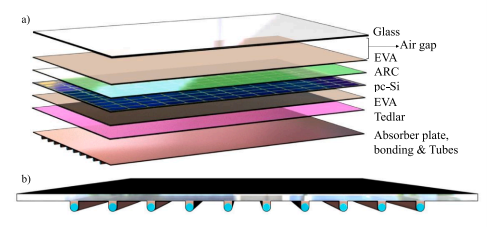Photovoltaic Thermal (PVT) System CFD Simulation Tutorial, DO Radiation Model Fluent Validation
Photovoltaic Thermal (PVT) System CFD Simulation Tutorial, DO Radiation Model Fluent Validation
- Upon ordering this product, you will be provided with a geometry file, a mesh file, and an in-depth Training Video that offers a step-by-step training on the simulation process.
- For any more inquiries regarding the product, please do not hesitate to reach out to us at info@CFDLAND.com or through our online support assistant.
€245 Original price was: €245.€185Current price is: €185.
A Photovoltaic Thermal System (PVT) combines two technologies to get electricity and heat from the sun at the same time. A PVT system CFD model shows us how solar panels make electricity from sunlight and also use the extra heat to warm up water. A Photovoltaic CFD / Fluent simulation is a great tool for this because it helps us improve energy efficiency and use the most of our solar resources. This makes a PVT system a very good choice for renewable energy in both homes and businesses. By combining these two functions, a Photovoltaic Thermal System Simulation helps us get the most energy possible out of one device.
This project is a validation study where we perform a solar energy CFD analysis. We simulated a PVT system using the DO radiation model in ANSYS Fluent. Our goal is to validate the results from the reference paper: “Coupled thermal-optical numerical modeling of PV/T module – Combining CFD approach and two-band radiation DO model [1]”.
- Reference [1]: Maadi, Seyed Reza, et al. “Coupled thermal-optical numerical modeling of PV/T module–Combining CFD approach and two-band radiation DO model.” Energy conversion and management198 (2019): 111781.

Figure 1- Schematic of the PVT system used for the coupled thermal-optical CFD analysis [1]
Simulation Process – PVT System Fluent Simulation
The PVT system has many different parts, so creating an accurate model requires care. First, we designed the geometry using ANSYS Design Modeler software. For this Photovoltaic CFD / Fluent simulation, we wanted to use a high-quality structured mesh. To do this, we divided the geometry into several blocks. This process makes it possible to create a hexagonal structured mesh using ANSYS Meshing. Figure 2 shows our final mesh, which has a total of 1,738,000 cells.
For the solver setup, we assumed that the walls are non-gray surfaces. This means their optical properties change with wavelength. We also assumed the solar radiation hits the module directly from above. A key part of this heat transfer analysis is that most thermal properties depend on temperature. The formula for viscosity was very complex, so we had to write a User-defined function (UDF) to define it correctly in ANSYS Fluent. Finally, to model the solar radiation, we employed the Discrete Ordinates (DO) radiation model.


Figure 2- High-quality structured mesh with 1,738,000 cells used for the PVT system CFD simulation.
Post-Processing – Photovoltaic Thermal System CFD Analysis
The heat transfer analysis of the PVT system shows an interesting mix of conduction and radiation. In our Photovoltaic Thermal System Fluent simulation, solar radiation passes through the glass and hits the pc-Si layer. Some energy becomes electricity, and the rest becomes heat. The temperature results show that the hottest areas are around the water tubes. A key finding is that the water heats up as it flows through the system, with its temperature increasing by 5.67K (from 311K at the inlet to 316.67K at the outlet). This shows that the system is capturing thermal energy very well. These temperature results prove that the DO radiation model is correctly simulating the coupled thermal-optical behavior.

Figure 3- Temperature distribution from the Photovoltaic CFD analysis on the absorber and tubes.
For our energy efficiency simulation, the most important validation result is the electrical efficiency. Our Photovoltaic Thermal System CFD simulation predicted a PV cell temperature of 317.74K. This is very close to the paper’s experimental value of 319.31K. This temperature leads to a calculated electrical efficiency of 10.1% in our simulation, compared to 10.42% in the paper. The most significant finding is that the difference is only 3.07%. This small error confirms that our simulation method is very accurate. The results prove that our structured mesh of 1.738 million cells was good enough to capture the complex physics of this PVT system.
| T-pv | η_elec | Error | |
| Paper Data | 319.31K | 10.42% | 3.07% |
| CFD Simulation | 317.74K | 10.1% |
We pride ourselves on presenting unique products at CFDLAND. We stand out for our scientific rigor and validity. Our products are not based on guesswork or theoretical assumptions like many others. Instead, most of our products are validated using experimental or numerical data from valued scientific journals. Even if direct validation isn’t possible, we build our models and assumptions on the latest research, typically using reference articles to approximate reality.
Yes, we’ll be here . If you have trouble loading files, having technical problems, or have any questions about how to use our products, our technical support team is here to help.
You can load geometry and mesh files, as well as case and data files, using any version of ANSYS Fluent.
€160 Original price was: €160.€110Current price is: €110.

€360 Original price was: €360.€185Current price is: €185.

€190 Original price was: €190.€125Current price is: €125.

€360 Original price was: €360.€185Current price is: €185.

€200 Original price was: €200.€115Current price is: €115.

€185 Original price was: €185.€135Current price is: €135.



















1 review for Photovoltaic Thermal (PVT) System CFD Simulation Tutorial, DO Radiation Model Fluent Validation
sedsajjad –
It was really great, thank you